21世纪报第5期day4阅读学案
- 格式:doc
- 大小:55.00 KB
- 文档页数:2
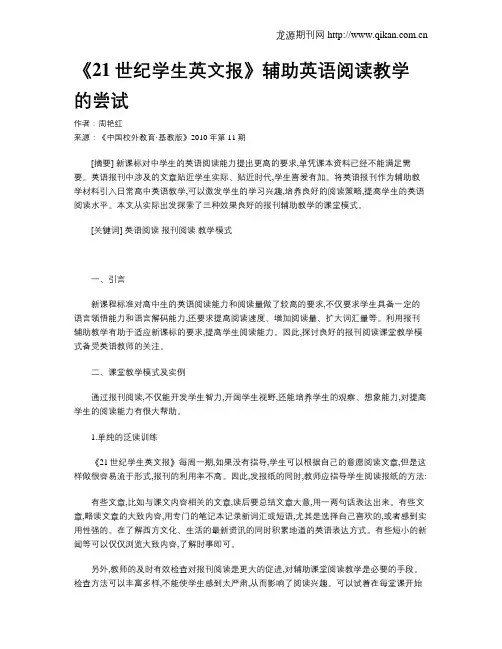
《21世纪学生英文报》辅助英语阅读教学的尝试作者:周艳红来源:《中国校外教育·基教版》2010年第11期[摘要] 新课标对中学生的英语阅读能力提出更高的要求,单凭课本资料已经不能满足需要。
英语报刊中涉及的文章贴近学生实际、贴近时代,学生喜爱有加。
将英语报刊作为辅助教学材料引入日常高中英语教学,可以激发学生的学习兴趣,培养良好的阅读策略,提高学生的英语阅读水平。
本文从实际出发探索了三种效果良好的报刊辅助教学的课堂模式。
[关键词] 英语阅读报刊阅读教学模式一、引言新课程标准对高中生的英语阅读能力和阅读量做了较高的要求,不仅要求学生具备一定的语言领悟能力和语言解码能力,还要求提高阅读速度、增加阅读量、扩大词汇量等。
利用报刊辅助教学有助于适应新课标的要求,提高学生阅读能力。
因此,探讨良好的报刊阅读课堂教学模式备受英语教师的关注。
二、课堂教学模式及实例通过报刊阅读,不仅能开发学生智力,开阔学生视野,还能培养学生的观察、想象能力,对提高学生的阅读能力有很大帮助。
1.单纯的泛读训练《21世纪学生英文报》每周一期,如果没有指导,学生可以根据自己的意愿阅读文章,但是这样做很容易流于形式,报刊的利用率不高。
因此,发报纸的同时,教师应指导学生阅读报纸的方法:有些文章,比如与课文内容相关的文章,读后要总结文章大意,用一两句话表达出来。
有些文章,略读文章的大致内容,用专门的笔记本记录新词汇或短语,尤其是选择自己喜欢的,或者感到实用性强的。
在了解西方文化、生活的最新资讯的同时积累地道的英语表达方式。
有些短小的新闻等可以仅仅浏览大致内容,了解时事即可。
另外,教师的及时有效检查对报刊阅读是更大的促进,对辅助课堂阅读教学是必要的手段。
检查方法可以丰富多样,不能使学生感到太严肃,从而影响了阅读兴趣。
可以试着在每堂课开始或最后留出部分时间:找学生介绍他最喜欢的文章的主要内容,吸引人之处,或读后的感受;找不同学生说出所读文章中他们积累或摘抄的词汇和优美词句;小组合作竞赛。
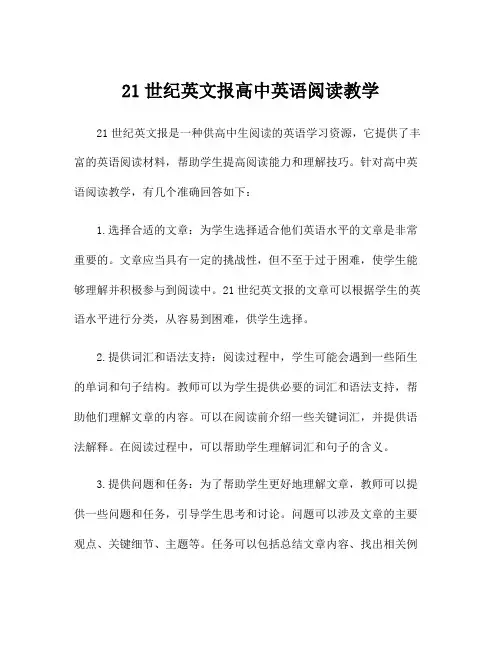
21世纪英文报高中英语阅读教学21世纪英文报是一种供高中生阅读的英语学习资源,它提供了丰富的英语阅读材料,帮助学生提高阅读能力和理解技巧。
针对高中英语阅读教学,有几个准确回答如下:1.选择合适的文章:为学生选择适合他们英语水平的文章是非常重要的。
文章应当具有一定的挑战性,但不至于过于困难,使学生能够理解并积极参与到阅读中。
21世纪英文报的文章可以根据学生的英语水平进行分类,从容易到困难,供学生选择。
2.提供词汇和语法支持:阅读过程中,学生可能会遇到一些陌生的单词和句子结构。
教师可以为学生提供必要的词汇和语法支持,帮助他们理解文章的内容。
可以在阅读前介绍一些关键词汇,并提供语法解释。
在阅读过程中,可以帮助学生理解词汇和句子的含义。
3.提供问题和任务:为了帮助学生更好地理解文章,教师可以提供一些问题和任务,引导学生思考和讨论。
问题可以涉及文章的主要观点、关键细节、主题等。
任务可以包括总结文章内容、找出相关例子等。
这样可以帮助学生更深入地理解文章,并培养他们的批判性思维和分析能力。
4.组织讨论和分享:教师可以组织学生进行小组或整体讨论,分享他们的理解和观点。
这样可以促进学生之间的合作和交流,互相学习和激发思考。
教师可以引导学生思考不同观点和意见,并帮助他们表达自己的观点。
5.鼓励阅读广泛:除了使用21世纪英文报的文章,教师还可以鼓励学生阅读其他形式和题材的英语材料,如小说、新闻、科普文章等。
通过阅读不同类型的文章,学生可以扩大词汇量,培养阅读兴趣,提高阅读能力。
总之,高中英语阅读教学需要根据学生的英语水平和学习需求,选择适合的材料,并采用多种教学方法和策略,帮助学生提高阅读能力和理解技巧。
21世纪英文报提供的文章可以作为一个很好的辅助资源。
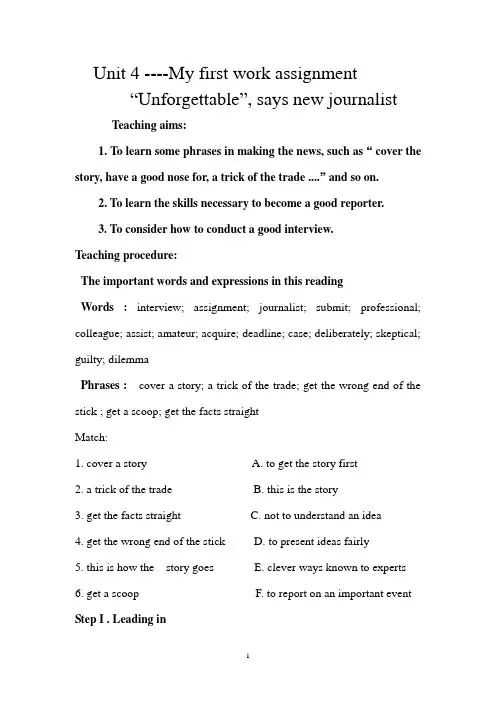
Unit 4 ----My first work assignment“Unforgettable”, says new journalist Teaching aims:1. To learn some phrases in making the news, such as “ cover the story, have a good nose for, a trick of the trade ....” and so on.2. To learn the skills necessary to become a good reporter.3. To consider how to conduct a good interview.Teaching procedure:The important words and expressions in this readingWords :interview; assignment; journalist; submit; professional; colleague; assist; amateur; acquire; deadline; case; deliberately; skeptical; guilty; dilemmaPhrases : cover a story; a trick of the trade; get the wrong end of the stick ; get a scoop; get the facts straightMatch:1. cover a story A. to get the story first2. a trick of the trade B. this is the story3. get the facts straight C. not to understand an idea4. get the wrong end of the stick D. to present ideas fairly5. this is how the story goes E. clever ways known to experts6. get a scoop F. to report on an important event Step I . Leading inStep II. While--reading1. Fast reading :How many questions did Zhou Yang ask his new boss, Hu Xin? What are they?(underline all the questions asked by Zhou Yang (ZY) and answer the following questions)2. Careful reading:Question 1: Could zhou Yang go out on a story alone?And why (not) ?Question 2: Need Zhou Yang take a camera?Question 3--7: Read line 16--29 carefully and fill in the blanks.Zhou Yang’s notesWe can get the skills to be a good reporter.Dos Don’ts1.A good reporter needs to be _____________2.A good reporter must have a good ___________ for a story.3.To ____________ all the 1.Don’t miss the ___________________.2.Don’t be _______________.information is necessary .3.Don’t ____________ too much.4._________ ___________ theinterview carefully.5.__________ the next question.6.Listening is important to get thefacts ___________.7.If the interviewee agrees, he canuse a __________Question 8-9: (line 30--41)Why did Hu Xin use the example of the footballer? ________A. To say they have never made any mistake.B. To prove a liar can never hide any secret.C. To show a reporter has to be careful about facts.D. To describe one of his terrible memories.3. Fill in the blanks.Here comes a story made up of the new words and phrases in this reading passage.When I was in high school, I fell in love with a pretty girl, which was considered ____________ in my teacher’s eyes.I loved her _________ much __________ I couldn't concentrate on my learning. So I ________________ whether to work hard at my lessons or to enjoy my love. I always____________borrowed her notebooks____________ catchher attention. Sometimes she would give me a sweet smile and I _____________________, thinking she loved me, too.Meanwhile, my teacher told me that if I didn't_____________________, I would remain single all my life! And the teacher was proved right!I was wrong.Step III:Post - reading :Your “First Assignment”Suppose you are reporters for China Daily, can you write a brief news story about Li Na?Li Na’s P rofile◊ 1982年出生于湖北武汉;◊ 1999年由业余球员转为职业运动员;◊成绩令人敬仰(30个冠军头衔);◊退役前十分纠结。
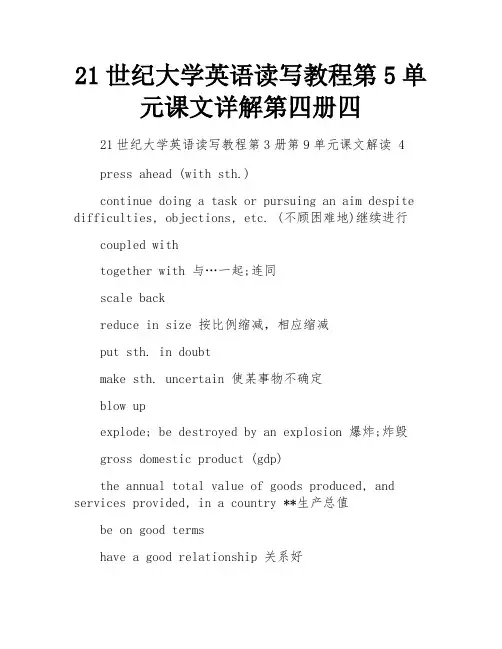
21世纪大学英语读写教程第5单元课文详解第四册四21世纪大学英语读写教程第3册第9单元课文解读 4press ahead (with sth.)continue doing a task or pursuing an aim despite difficulties, objections, etc. (不顾困难地)继续进行coupled withtogether with 与…一起;连同scale backreduce in size 按比例缩减,相应缩减put sth. in doubtmake sth. uncertain 使某事物不确定blow upexplode; be destroyed by an explosion 爆炸;炸毁gross domestic product (gdp)the annual total value of goods produced, and services provided, in a country **生产总值be on good termshave a good relationship 关系好be caught inbe involved in 陷入,卷入21世纪大学英语读写教程第3册第9单元课文解读 5* rivalryn. active petition between people 竞争;对抗craftn. 1. (pl. unchanged) a boat, ship, aircraft, etc. 小船;船;飞机;飞行器2. skill and care in doing or making sth. 工艺;手艺3. a trade or profession requiring skill and care (需要特种手艺的)行业;职业4. 诡计;手腕* shuttlen. 航天飞机v. go from one place to another 穿梭往返extraterrestriala. happening, existing or ing from somewhere beyond earth 地球(或其大气圈)外的;行星际的`;宇宙的militarya. of or for soldiers or an army 军事的n. (the ~ ) soldiers or the army; the armed forces **;**;武装部队aeronauticsn. the scientific study or practice of constructing and flying aircraft 航空学space explorationn. 外层空间探索* collaborationn. working together with sb., esp. to create or produce sth. 合作,协作cancelvt. order (sth.) to be stopped; make (sth.) no longer valid 取消;废除rocketn. 火箭vi. move very fast; rise quickly and suddenly 飞速前进;猛涨* impetusn. a force that encourages a process to develop more quickly 推动力;刺激controversyn. fierce argument or disagreement about sth., esp. one that is carried on in public over a long period 争论;争议worthwhilea. worth doing; worth the trouble taken 值得做的;值得花费时间(精力)的orbitn. a path followed by an object, eg. a spacecraft, round a planet, star, etc. [天]轨道v. move in orbit round sth. 环绕(天体的)轨道运行planetarya. 行星的grossa. total; whole 总的;毛的timewarpn. (in science fiction) a situation in whichpeople or things from one point in time are moved toor trapped in another point in time (科幻作品中)时间异常(或间断、暂停)warpn. 1. a bend or twist 变形;翘曲2. a fault or abnormality in a person's character 反常心理;乖戾21世纪大学英语读写教程第5单元课文详解第四册 (菁选3篇)(扩展3)——21世纪大学英语读写教程第5单元课文详解第四册范本4份21世纪大学英语读写教程第5单元课文详解第四册 1emulatevt. imitate, especially from respect 仿效,模仿penmanshipn. the skill or style of handwriting 书写的技巧(或风格),书法tabletn. 1. a pad of writing paper glued together along one edge 便笺簿,拍纸簿2. 药片thumbvi. (through) turn the pages of (a book, etc.) quickly 迅速翻阅(书等)painstakinga. done with, requiring or taking great care or trouble 刻苦的,下苦功的;煞费苦心的punctuationn. 标点符号 (=punctuation mark)burrowvt. dig (a hole, etc.) 挖(洞等)mammaln. 哺乳动物termiten. 白蚁anteatern. any of several mammals that feed largely or entirely on ants or termites 食蚁动物miniaturea. very much smaller in size than is usual or normal 微型的,小型的inevitablea. incapable of being avoided or evaded 不可避免的`word-basen. the vocabulary one mands 词汇量broadenv. (cause to) bee broad(er) (使)变宽,(使)变阔,扩大bunkn. a narrow bed built into a wall like a shelf (倚壁而设的)床铺wedgen. 1. 楔子2.(打高尔夫球用的)楔形铁头球棒correspondencen. munication by letters 通信correspondvi. 1. (with) 通信2. (to, with) 相符合;成一致3. (to) 相当,相类似imprisonvt. put or keep (sb.) in or as if in prison 监禁,关押;禁锢rehabilitationn. restoration to a condition of health or useful and constructive activity 康复;(**的)改造inmaten. a person confined (as in a prison or hospital) 囚徒;被收容者;住院者intensea. existing in an extreme degree 强烈的,极度的well-reada. well informed or deeply versed through reading 博学的,博览群书的debatern. 辩论家,好辩论者devourvt. enjoy avidly 贪婪地看(或听、读等)literaturen. 文学,文学作品maximumn. the greatest quality or value attainable or attained 最大值,最大限度a. as high, great, intense, etc. as possible 最高的;最大的;最强的isolationn. solitude 隔离;孤立outragevt. make very angry and shocked 激怒;激起…的义愤n. 1. a feeling of great anger and shock 义愤,愤怒2. a very cruel, violent, and shocking action or event 暴行;骇人听闻的事件engrossinga. taking up sb.'s attention pletely 使人全神贯注的corridorn. a passageway into which partments or rooms open 走廊,过道intervaln. a space of time between events; a space between objects, points or states (时间的)间隔;间歇;(空间的)间隔;空隙footstepn. 脚步,脚步声feignvt. give a false appearance of 假装,佯作light-glown. 灯光vistan. 远景;前景dormanta. temporarily inactive 暂停活动的;休眠的;潜伏的confervt. give or grant (a degree or title) to sb. 授予(某人)(学位或头衔)vi. discuss, talk together 讨论,商谈sensitivityn. the quality or state of being sensitive **(性)dumbnessn. lack of power of speech 哑alma matern. a school, college, or university which one has attended or from which one has graduated 母校intensivelyad. 加强地;集中地;密集地;透彻地ignorancen. the state or fact of lacking knowledge 无知,愚昧。
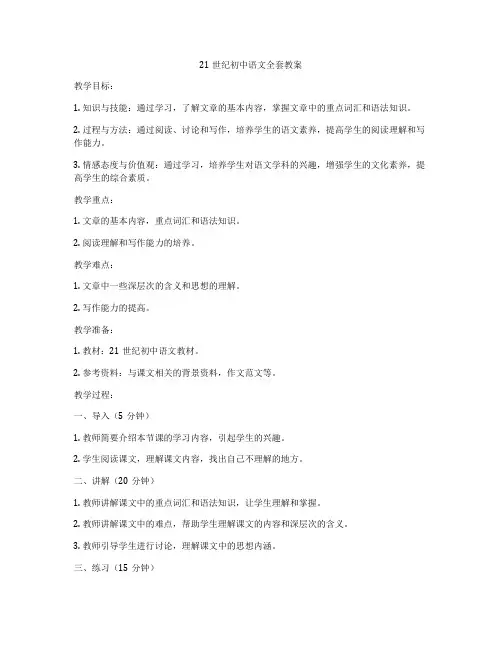
21世纪初中语文全套教案教学目标:1. 知识与技能:通过学习,了解文章的基本内容,掌握文章中的重点词汇和语法知识。
2. 过程与方法:通过阅读、讨论和写作,培养学生的语文素养,提高学生的阅读理解和写作能力。
3. 情感态度与价值观:通过学习,培养学生对语文学科的兴趣,增强学生的文化素养,提高学生的综合素质。
教学重点:1. 文章的基本内容,重点词汇和语法知识。
2. 阅读理解和写作能力的培养。
教学难点:1. 文章中一些深层次的含义和思想的理解。
2. 写作能力的提高。
教学准备:1. 教材:21世纪初中语文教材。
2. 参考资料:与课文相关的背景资料,作文范文等。
教学过程:一、导入(5分钟)1. 教师简要介绍本节课的学习内容,引起学生的兴趣。
2. 学生阅读课文,理解课文内容,找出自己不理解的地方。
二、讲解(20分钟)1. 教师讲解课文中的重点词汇和语法知识,让学生理解和掌握。
2. 教师讲解课文中的难点,帮助学生理解课文的内容和深层次的含义。
3. 教师引导学生进行讨论,理解课文中的思想内涵。
三、练习(15分钟)1. 学生进行阅读理解练习,教师给予指导和帮助。
2. 学生进行写作练习,教师给予指导和评价。
四、总结(5分钟)1. 教师总结本节课的学习内容,强调重点和难点。
2. 学生分享自己的学习收获和感受。
教学评价:1. 课后作业的完成情况,检查学生对课文内容的理解和掌握。
2. 阅读理解和写作练习的完成情况,检查学生的阅读理解和写作能力。
3. 学生的课堂表现,了解学生的学习兴趣和积极性。
以上是一套21世纪初中语文的教案,根据教学目标和教学内容进行设计,注重学生的阅读理解和写作能力的培养,同时培养学生的语文素养和文化素养。
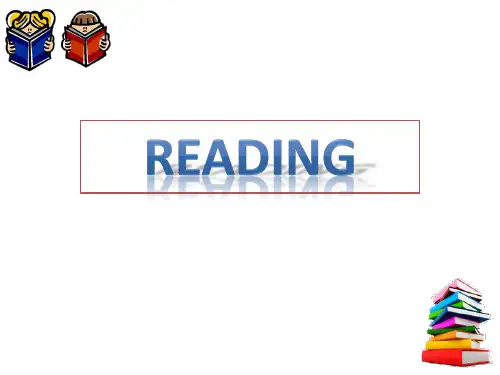
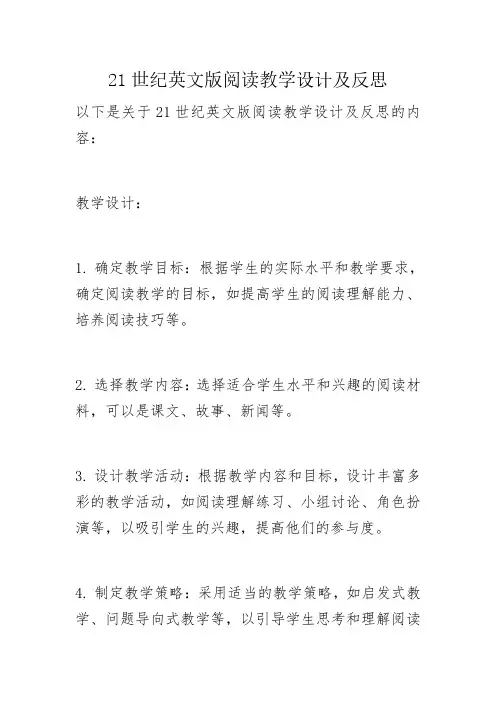
21世纪英文版阅读教学设计及反思
以下是关于21世纪英文版阅读教学设计及反思的内容:
教学设计:
1.确定教学目标:根据学生的实际水平和教学要求,确定阅读教学的目标,如提高学生的阅读理解能力、培养阅读技巧等。
2.选择教学内容:选择适合学生水平和兴趣的阅读材料,可以是课文、故事、新闻等。
3.设计教学活动:根据教学内容和目标,设计丰富多彩的教学活动,如阅读理解练习、小组讨论、角色扮演等,以吸引学生的兴趣,提高他们的参与度。
4.制定教学策略:采用适当的教学策略,如启发式教学、问题导向式教学等,以引导学生思考和理解阅读
材料。
5.设计评估方式:制定评估学生阅读水平和教学效果的方式,如阅读测试、口头报告等。
教学反思:
1.反思教学效果:评估教学目标的达成情况,以及学生的学习效果,以便调整教学策略。
2.反思教学过程:反思教学活动的设计和实施情况,寻找可以改进的地方。
3.反思学生反馈:收集学生对教学的意见和建议,以便改进教学。
4.反思教学资源:评估教学资源的有效性和适用性,寻找更适合的教学资源。
通过不断的教学设计和反思,教师可以不断提高自己的教学水平,使学生更好地掌握阅读技能。
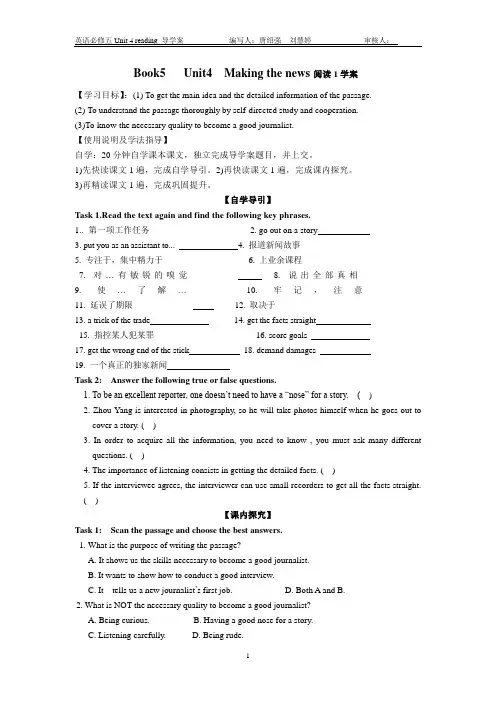
Book5 Unit4 Making the news阅读1学案【学习目标】:(1) To get the main idea and the detailed information of the passage.(2) To understand the passage thoroughly by self-directed study and cooperation.(3)To know the necessary quality to become a good journalist.【使用说明及学法指导】自学:20分钟自学课本课文,独立完成导学案题目,并上交。
1)先快读课文1遍,完成自学导引。
2)再快读课文1遍,完成课内探究。
3)再精读课文1遍,完成巩固提升。
【自学导引】Task 1.Read the text again and find the following key phrases.1.. 第一项工作任务______________2. go out on a story3. put you as an assistant to...4. 报道新闻故事________________5. 专注于,集中精力于__________________6. 上业余课程______________7. 对…有敏锐的嗅觉___________ _ 8. 说出全部真相______________ 9. 使…了解…______________10. 牢记,注意___________ 11. 延误了期限______________ 12. 取决于______________________13. a trick of the trade 14. get the facts straight15. 指控某人犯某罪_____________ 16. score goals17. get the wrong end of the stick 18. demand damages19. 一个真正的独家新闻Task 2: Answer the following true or false questions.1. To be an excellent reporter, one doesn’t need to have a “nose” for a story. ()2. Zhou Yang is interested in photography, so he will take photos himself when he goes out tocover a story. ( )3. In order to acquire all the information, you need to know , you must ask many differentquestions. ( )4. The importance of listening consists in getting the detailed facts. ( )5. If the interviewee agrees, the interviewer can use small recorders to get all the facts straight. ( )【课内探究】Task 1: Scan the passage and choose the best answers.1. What is the purpose of writing the passage?A. It shows us the skills necessary to become a good journalist.B. It wants to show how to conduct a good interview.C. It tells us a new journalist’s first job.D. Both A and B.2. What is NOT the necessary quality to become a good journalist?A. Being curious.B. Having a good nose for a story.C. Listening carefully.D. Being rude.3. Which of the following statement is TRUE according to the text?A. A journalist can always use a recorder to get the facts straight.B. A journalist can ask any questions as they wish.C. When people telling lies, journalists can point them out straight.D. A good journalist can avoid being accused of getting the right end of the stick.4. The footballer was thought to be guilty because ______.A . he usually told lies B. he stopped the reporter publishing an articleC. he took money for not scoringD. he bribed another football team5. From the dialogue, we know that the boss ______.A. isn’t satisfied with Zhou YangB. doesn’t believe in Zhou Yang’s abilityC. is strict with Zhou YangD. is helpful to Zhou Yang with his workTask 2: Underline the following sentences in the text and finish the questions.1. _______ _________ Zhou Yang forget his first assignment at the office of a popular English newspaper.这是一个__________句型, ___________ 放在句首,句子________________.2. Not only ______ ________ ______ _______ __________(我对摄影感兴趣), but I took an amateur course at university to update my skill.Not only …but also …连接两个句子,not only 后面的句子____________.3. How can I listen carefully ________ _________ __________(当做笔记的时候)? 所填部分是一个_________句,补充完成是__________________________。
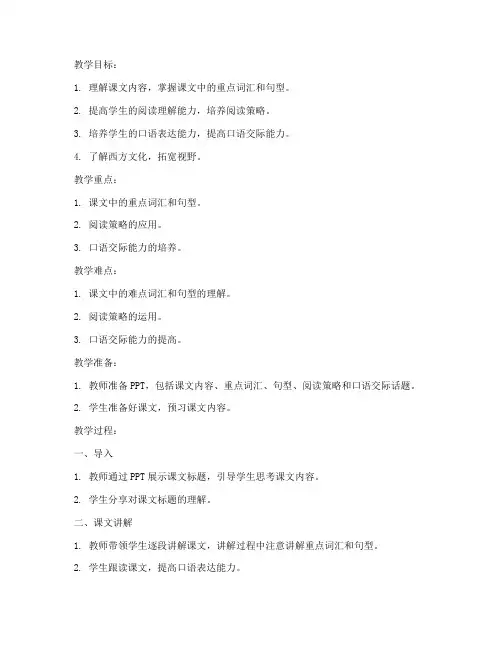
教学目标:1. 理解课文内容,掌握课文中的重点词汇和句型。
2. 提高学生的阅读理解能力,培养阅读策略。
3. 培养学生的口语表达能力,提高口语交际能力。
4. 了解西方文化,拓宽视野。
教学重点:1. 课文中的重点词汇和句型。
2. 阅读策略的应用。
3. 口语交际能力的培养。
教学难点:1. 课文中的难点词汇和句型的理解。
2. 阅读策略的运用。
3. 口语交际能力的提高。
教学准备:1. 教师准备PPT,包括课文内容、重点词汇、句型、阅读策略和口语交际话题。
2. 学生准备好课文,预习课文内容。
教学过程:一、导入1. 教师通过PPT展示课文标题,引导学生思考课文内容。
2. 学生分享对课文标题的理解。
二、课文讲解1. 教师带领学生逐段讲解课文,讲解过程中注意讲解重点词汇和句型。
2. 学生跟读课文,提高口语表达能力。
三、阅读策略训练1. 教师引导学生分析课文结构,总结阅读策略。
2. 学生练习运用阅读策略,提高阅读理解能力。
四、口语交际训练1. 教师根据课文内容,设计口语交际话题。
2. 学生分组进行口语交际练习,教师巡回指导。
五、课堂小结1. 教师总结本节课的重点内容,强调重点词汇和句型。
2. 学生分享自己的学习心得。
六、课后作业1. 完成课文后的练习题。
2. 搜集与课文内容相关的资料,撰写一篇短文。
教学反思:本节课通过讲解课文、阅读策略训练和口语交际训练,帮助学生掌握课文内容,提高阅读理解能力和口语表达能力。
在教学过程中,教师应注意以下几点:1. 注重学生的参与,鼓励学生积极发言。
2. 引导学生运用阅读策略,提高阅读理解能力。
3. 针对学生的口语交际能力,给予充分的指导。
4. 注重课后作业的布置,巩固所学知识。
通过本节课的学习,学生能够更好地掌握《21世纪大学英语4》Unit 1的内容,提高英语综合运用能力。
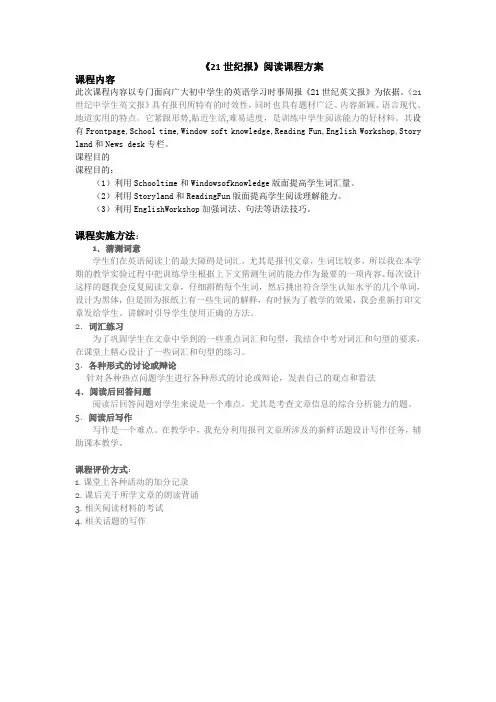
《21世纪报》阅读课程方案课程内容此次课程内容以专门面向广大初中学生的英语学习时事周报《21世纪英文报》为依据。
《21世纪中学生英文报》具有报刊所特有的时效性,同时也具有题材广泛、内容新颖、语言现代、地道实用的特点。
它紧跟形势,贴近生活,难易适度,是训练中学生阅读能力的好材料。
其设有Frontpage,School time,Window soft knowledge,Reading Fun,English Workshop,Story land和News desk专栏。
课程目的课程目的:(1)利用Schooltime和Windowsofknowledge版面提高学生词汇量。
(2)利用Storyland和ReadingFun版面提高学生阅读理解能力。
(3)利用EnglishWorkshop加强词法、句法等语法技巧。
课程实施方法:1.猜测词意学生们在英语阅读上的最大障碍是词汇,尤其是报刊文章,生词比较多,所以我在本学期的教学实验过程中把训练学生根据上下文猜测生词的能力作为最要的一项内容。
每次设计这样的题我会反复阅读文章,仔细斟酌每个生词,然后挑出符合学生认知水平的几个单词,设计为黑体,但是因为报纸上有一些生词的解释,有时候为了教学的效果,我会重新打印文章发给学生。
讲解时引导学生使用正确的方法。
2.词汇练习为了巩固学生在文章中学到的一些重点词汇和句型,我结合中考对词汇和句型的要求,在课堂上精心设计了一些词汇和句型的练习。
3.各种形式的讨论或辩论针对各种热点问题学生进行各种形式的讨论或辩论,发表自己的观点和看法4.阅读后回答问题阅读后回答问题对学生来说是一个难点,尤其是考查文章信息的综合分析能力的题。
5.阅读后写作写作是一个难点。
在教学中,我充分利用报刊文章所涉及的新鲜话题设计写作任务,辅助课本教学。
课程评价方式:1.课堂上各种活动的加分记录2.课后关于所学文章的朗读背诵3.相关阅读材料的考试4.相关话题的写作。
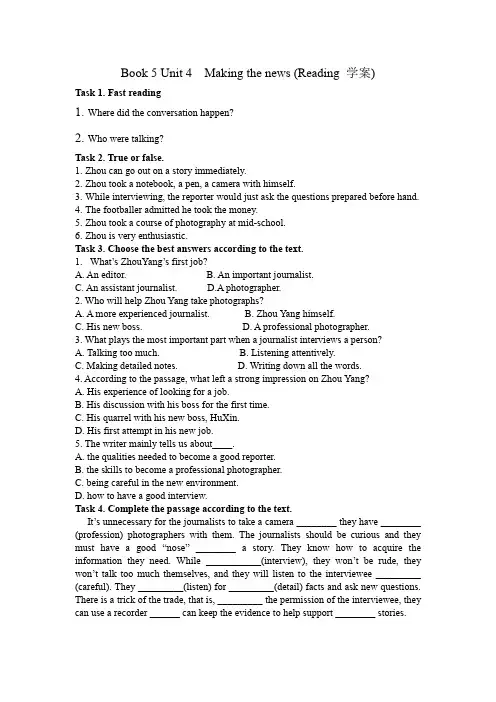
Book 5 Unit 4 Making the news (Reading 学案)Task 1. Fast reading1.Where did the conversation happen?2.Who were talking?Task 2. True or false.1.Zhou can go out on a story immediately.2.Zhou took a notebook, a pen, a camera with himself.3.While interviewing, the reporter would just ask the questions prepared before hand.4.The footballer admitted he took the money.5.Zhou took a course of photography at mid-school.6.Zhou is very enthusiastic.Task 3. Choose the best answers according to the text.1.What’s ZhouYang’s first job?A. An editor.B. An important journalist.C. An assistant journalist.D.A photographer.2. Who will help Zhou Yang take photographs?A. A more experienced journalist.B. Zhou Yang himself.C. His new boss.D. A professional photographer.3. What plays the most important part when a journalist interviews a person?A. Talking too much.B. Listening attentively.C. Making detailed notes.D. Writing down all the words.4. According to the passage, what left a strong impression on Zhou Yang?A. His experience of looking for a job.B. His discussion with his boss for the first time.C. His quarrel with his new boss, HuXin.D. His first attempt in his new job.5. The writer mainly tells us about____.A. the qualities needed to become a good reporter.B. the skills to become a professional photographer.C. being careful in the new environment.D. how to have a good interview.Task 4. Complete the passage according to the text.It’s unnecessary for the journalists to take a camera ________ they have ________ (profession) photographers with them. The journalists should be curious and they must have a good “nose”________ a story. They know how to acquire the information they need. While ___________(interview), they won’t be rude, they won’t talk too much themselves, and they will listen to the interviewee _________ (careful). They _________(listen) for _________(detail) facts and ask new questions. There is a trick of the trade, that is, _________ the permission of the interviewee, they can use a recorder ______ can keep the evidence to help support ________ stories.。
运用《21世纪学生英文报》开展阅读教学的探索[摘要] 本文针对当前go for it 教材不能满足课标规定的中学生英语阅读量的问题,提出了利用《21世纪学生英文报》开展课内外报刊阅读教学。
笔者根据自己的教学实践,阐述了运用该报刊进行阅读教学的方法、过程和成效等内容。
[关键词] 报刊阅读操作方式组织形式成效一、问题的提出《英语课程标准》指出,初中阶段必须达到课标5级的要求,能读懂7—9年级学生阅读的简单读物和报刊、杂志,能够克服生词障碍,理解大意,能根据阅读目的运用适当的阅读策略。
另外,课标在5级阅读技能目标里还明确要求学生除教材外,课外阅读量应累计达到15万词以上。
前几年,由于各方面的限制,我们仅仅以课本为依托进行教学,导致很多学生思维不够开拓,英语语言运用单一,跟不上其它各地的英语水平。
当前,我市初中英语教材的内容主要以词汇、语法为主,长篇阅读材料内容较少,由于教材编写时的年代过时且滞后,已经跟不上当前学生丰富的社会知识。
所以,很多学生逐渐失去了学习英语的兴趣。
他们希望通过一种轻松愉悦、新颖的课外阅读形式去摄取更多地道的语言材料,了解更多与时代接轨的信息。
因此,开展报刊阅读势在必行。
二、选用《21世纪学生英文报》的缘由近几年的中考试题涉及的文章语言地道、优美,内容紧跟时代,贴近生活,题材新颖多样。
两年前,笔者参加了本市中考英语命题工作,命题过程中积累了很多的经验,了解到英语的阅读文章体裁多样,语言地道。
《21世纪学生英文报》的内容非常符合学生的阅读需要,于是订阅了《21世纪学生英文报》。
《21世纪中学生英文报》满足了学生的需求,它题材广泛,内容丰富,涉及娱乐、体育、历史、科技等多方面,形式多样,有新闻报道、原版读物、幽默笑话、学生习作、美文欣赏等,以独特的视角为中学生提供了充满生机、妙趣横生、富有感染力的阅读空间。
通过阅读《21世纪中学生英文报》,笔者想达到以下预期目标:激发学生阅读的兴趣,提高英语学习的积极性;通过各种形式的阅读,培养学生缩写和概括总结的能力;积累词汇量,巩固所学新词,提高写作能力;通过阅读报刊培养学生良好的阅读策略和习惯。
初中21世纪学生英文报阅读课程设计方案一、课程背景:在当今信息时代,培养学生的英文报阅读能力至关重要。
通过阅读英文报,学生不仅能提升英语水平,还能了解国际社会的多元文化,拓宽视野。
因此,本课程设计旨在激发学生对英文报的兴趣,提高其阅读能力,培养跨文化交际的素养。
二、课程目标:提高学生的英文报阅读能力,包括阅读速度、理解力和批判性思维。
激发学生对国际时事、文化、科技等方面的兴趣。
培养学生的英语表达和写作能力。
引导学生发展自主学习的能力。
三、教学内容与安排:第一周:课程介绍与期望介绍课程目标和重要性。
引导学生讨论他们对英文报的期望。
第二周:英文报基础知识学习英文报的结构和常见词汇。
引导学生分析报纸中的标题、导语等。
第三至第六周:阅读技巧与练习学习阅读技巧,包括扫读、略读、深度阅读等。
每周选择一篇新闻、一篇特稿,进行课堂阅读训练。
第七至第八周:跨文化理解通过选读有关不同文化的文章,培养学生的跨文化交际意识。
开展小组讨论,分享对文化差异的看法。
第九至第十周:写作技巧培训学习报告、评论、读后感等英文报写作技巧。
学生选择一篇文章,进行写作练习,并相互修改。
第十一至第十二周:个性化拓展学生选择自己感兴趣的主题,阅读相关文章。
进行个性化研究报告,展示给全班。
四、评估方式:日常阅读报告:每周提交一篇对所读文章的感想和理解。
课堂参与:主动提问、小组讨论、展示等。
写作作业:包括新闻报告、评论、个人研究报告等。
期末考试:综合测试学生对英文报的阅读和理解能力。
五、教学方法:互动授课:利用多媒体、小组讨论等方式,激发学生兴趣。
实践性学习:定期进行阅读、写作和讨论实践,巩固所学知识。
个性化辅导:针对学生不同水平和需求,提供个性化指导。
通过这一课程设计,旨在培养学生的英文报阅读能力,提高他们的国际视野和跨文化交际能力,为未来的学习和职业发展打下坚实基础。
21世纪英语报第五、六期-九年级报纸阅读命题(A)Fifth graders in Zhejiang province will haveTCM courses (中医药课程)beginning thissemester.Xu Yueru, 14Learning traditional Chinese medicine (TCM) is a good way for students to have a better understanding of themselves. They can change their bad habits and pick up (养成) healthy ones. Also, children in Grade 5 are curious about everything. It is a good time to develop an interest in TCM, which is part of traditional Chinese culture. There is nothing wrong with learning more about our own culture.Shan Xi, 14TCM has existed for thousands of years. It shows the wisdom of our ancestors (祖先) and covers a lot of Chinese culture. It can teach students some basic knowledge about healthcare and broaden their horizons. Maybe some students want to be doctors. This class can help them learn a lot about medicine.Gao Yongtian, 14TCM is too complicated (复杂的) to understand. If they want to know more about healthcare, they can learn about first-aid (急救). It’s more useful. Plus, primary school students nowadays have heavy pressure in their studies. Learning TCM at school may take up too much of their time and bring them more pressure.Ge Huaiqi, 12Some knowledge about TCM doesn’t have enough scientific proof (依据). Some of its ideas still need to be proved in the future. It is not proper (合适的) to make students learn about it from a young age. Moreover, there are many complicated concepts (概念) in TCM. It’s even hard for adults to understand, let alone children. Gradually, they may lose interest in study.1. What does the underlined word"ones" refer to? (指代关系)A.students.B.habitsC. bodiesD.children(B)We all know that dogs eat poop (粪便). Although it appears strange to humans, scientists say it is a common practice for a lot of other animals: rabbits, rats,dogs, baby elephants and gorillas (猩猩). The list is long.These animals eat droppings to get nutrients (营养) they couldn’t digest (消化) the first time around, reported Live Science website.For example, rabbits eat a certain kind of droppings called cecotropes (盲肠便), which are products of the cecum (盲肠). Cecotropes are dark and soft, while actual feces are usually brown and hard. Scientists say cecotropes are very rich in nutrients and is essential (重要的) to rabbit’s good health.Many baby animals –including elephants and hippo calves (河马幼崽) –eat feces from their mothers or other members of the herd. It usually happens when they are growing from drinking their mother’s milk to eating solid food, scientists say.Eating feces helps these animal babies build healthy bacterial (细菌的) communities in their guts (肠道). It in turn helps digestion.1. What does "which" refer to in Paragraph 3? (指代关系)A. droppingsB. rabbitsC. cecotropesD. cecum2.The reason for baby animals eating poop are the followings EXCEPT _________ (细节判断) A. Cecotropes are rich in nutrients they couldn’t digest.B. Eating feces helps them build healthy bacterial communities in their guts.C. Eating feces improves digestion.D. Poop is easy to digest.3. If the writer continues to write this passage, what will he write about? (逻辑推理)A.When the animal babies stop eating feces.B. Why the animal babies eat feces.C. How the bacterial communities helps digestion.D. What kind of nutrients the animals can getfrom the feces.4. According to the passage, we can know__________. (文章主旨和拟标题)A. how the animals eat fecesB. how often the animals eat fecesC. why the animals eat fecesD. when the animals eat feces(C)What do you use to unlock your cellphone?A password? A fingerprint? Or simply a glance (一瞥)?On Sept 12, Apple introduced its iPhone X, which has an eye-catching feature (特色) -Face ID.With Face ID, Apple says, you can unlock your new iPhone by just looking at it. It is powered by a so-called TrueDepth camera system built into the front of the iPhone X.When the camera system sees a person’s face, it uses 30,000 unseen dots (点) to “map” (勾画) the shape and outline of the face. A mathematical model of the face will then becreated and stored (储存) in the phone.The next time the person looks at the iPhone X, the same dots are mapped onto his or her face and compared to the stored model. If the two match, then the phone unlocks. This happens in less than a second.Apple says the system is smart. If you change your hairstyle, put on sunglasses or makeup, or use the phone in the dark, Face ID still works. Although the technology sounds fancy, there are still concerns (担心). For example, will Face ID work for twins?According to Apple, the chance of others to unlock your iPhone X using Face ID is one in a million. Face ID can tell the difference between twins, but the error rating (出错率) rises. So one would need to set a password then.Apple also emphasizes (强调) that Face ID only unlocks when you stare at it. It is what Apple calls “attention aware (察觉)”. So the phone won’t unlock if you are just glancing at the phone for the time. It won’t work either ifsomeone puts the phone at your sleeping face or your photo.1. What does "which" refer to in Paragraph 2? (指代关系)A.a cellphoneB. AppleC. iPhone XD. Face ID2.If Michael wants to unlock his new iPhone X with Face ID, what shouldn’t he do? (细节判断)A. Wear sunglassesB. Have his hair cut.C. Unlock it at nightsD. Glance at it for a short time.3. We can infer from the passage that if you want to unlock an iPhone X of your twin sister or brother, you can _________.(逻辑推理)A. stare at it with sunglasses B. glance at it with a makeupC. use a passwordD. use your twin sister's or brother's face when sleeping4. What is the best title for the passage? (文章主旨和拟标题)A. The introduction of the iPhone XB. The features of the iPhone XC. Unlock the iPhone X by a glanceD. Unlock the iPhone X by attention aware(D)Old soap is changing people’s lives in Cambodia. A nonprofit (非盈利的) group named Eco-Soap Bank collects (收集) used soap from hotels and turns them into new bars to give out to people. Samir Lakhani, from the US, started this project three years ago.He visited Cambodia in Southeast Asia for the first time in 2014. In a village, he watched a mother bathe (洗澡) her baby using detergent (洗衣粉). He learned that many people in Cambodia are very poor. They don’t have clean running water to wash with. Many don’t even have soap at all. He realized that was a problem he could help solve.Lakhani’s ide a was to recycle old soap. Each year, millions of tourists visit Cambodia.The country’s many hotels use large amounts of soap. A hotel can produce 150 pounds (about 68 kg) of soap waste every month. So Lakhani went from hotel to hotel, asking if they could donate (捐赠) used soap.His project grew. It later became theEco-Soap Bank. The group takes used soap to recycling places. There, the soap is cleaned, then cut up, mixed together and put through a press (压模机). Soap waste becomes brand-new bars or liquid (液体) soap.Eco-Soap Bank gives soap to Cambodians. Some bars are also given to local women to sell. They make money for their families.The project has helped half a million Cambodians get cleaner. But Lakhani has a bigger plan. He wants to start Eco-Soap Bank in every tourist area around the world. All in all, he wants to help people take their health into their own hands -one bar of soap at a time.1. What does the underlined word in Paragraph 3 mean? (推测词意)A.To sell something that has benn usedB.To treat something used and use it agian.C.To use something old to do other things.D.To buy something that has benn used2.Samir Lakhani made a decision to recycle old soap ______________________. (细节判断) A. when he saw a father bathe her baby using detergent.B. because he wanted to helped Cambodians get richer.C. by going from hotel to hotel to ask for donations of used soap.D. so that he could start Eco-Soap.3. What's Lakhani’s purpose to set up Eco-Soap Bank? (逻辑推理)A. He wants to be known to all over the world.B. He wants to save money for the poor by recycling the used soap.C. He wants to help poor Cambodians to become healthy.D. He wants to help poor Cambodians to become rich.4. What is the passage about? (文章主旨和拟标题)A. It is about Samir Lakhani collecting soap.B. It is about the recycle of old soap.C. It is about how Eco-Soap Bank develops.D. It is about why Eco-Soap Bank started.(E)Social media have made animals become famous easier than ever before. Many people post their pets’ photos online and quickly get hundreds of thousands of followers. The pet doesn’t have to be a dog or cat. There are successful examples of foxes, pigs and birds. If your pet can perform on video, that’s even better.But it takes more than just a cute pet and an iPhone to create a popular pet account(账号). If you want to try for yourself, here are some tips for you.Know your brand (品牌)When you start your account on social media, choose a few words and phrases for yourpet’s “brand”. Is your pet a troublemaker? Silly and a natural performer (表演者)? Make sure all your photos have a similar theme (主题). That way your followers know what to expect of your account.For example, if your pet’s brand is“free-spirited (自由自在的) and loves nature”, don’t post photos of it sitting in a first-class seat with an expensive pet dish.Post photos regularly (定期地) and use hasgtags (话题标签)Plan to post, if not every day, then at least five days a week. When you post, add a few hashtags so people can find your account easily using the “Discover” feature on social media. You may look at accounts similar to yours and see which hashtags they’re using.Have fun or don’t do itYou have to love taking photos of your pet. Or at least you like doing it enough that you can get it done even when you don’t feel like it. But if you aren’t having a good time, it’s not worthit.1. What does the underlined word"troublemaker" mean? (推测词义)A.The one that usually causes problems.B.The trouble,pain and difficulties.C.To get into trouble easily.D.To have trouble doing something.2.If Mary wants to create a popular pet account, she can’t ________________ (细节判断)A. brand her pets with only a few words.B. post her pet’s photos every day.C. ignore the use of hasgtags.D. take photos of her pet.3. According to the passage, which of the following actions will the writer NOT support?(逻辑推理)A. Create an account on social media.B. Share the cute and funny moments online everyday.C. Form a habit of taking photos of your pet though you're not interested.D. Think of a theme for your pet and takephotos for it.4. What does the passage mainly talk about? (文章主旨和拟标题)A. The way to fi nd out your pet’s brand.B. Animals become famous easier than before.C. Using hashtags to make your pet known.D. Tips for making your pets celebrated.。
浅谈《21世纪学生英文报》阅读个性化教学作者:花文丽来源:《学校教育研究》2016年第01期自从我校2010年申报了“十一五”科研规划重点课题英语报刊教学综合探究项目起,我本人就亲自参与了《21世纪学生英语报》的阅读教学。
通过两批学生的尝试性教学,我感悟很深,以下把自己走过的教学过程做一个总结和分析。
一、研读课标,领会精神新版课标要求:义务教育阶段力求面向学生,为学生发展综合语言运用打好基础,合理利用各种教学资源,培养学生自主学习能力,提高学生学习的效率,为学生可持续发展奠定基础。
在此期间,课外阅读量应累计达到15万词以上。
根据我校学生发展状况与实际教学条件,《21世纪学生英语报》的阅读,正好符合课标的要求,也为教学目标的落实,提供了更多的教学手段,进一步拓展了学生自主学习的渠道和空间,开阔了视野,有利于鼓励、吸引、激发学习困难的学生参与英语的学习。
学生能够通过各种题材的文章,亲身体验学英语的兴趣和动力,所以《21世纪学生英文报》的阅读可谓是提高教学效率很好的辅助材料,尤其是为初中英语阅读能力的提高有着很大的促进作用。
二、学习报纸,贯彻精神如何利用报刊阅读服务课标的要求与教学目标的实现呢?报纸的好处与自身的优势有哪些呢?两年的教学使我深深感受到报纸的特点:内容丰富、题材新颖、图文并茂、时代感强,能迎合与满足不同个性学生的阅读和欣赏,文章内容难度适中,生动活泼,涉及了时事、政治、经济、科技、文化、生活、娱乐等不同方面的知识,信息量大,有利于激发学生的学习欲望,甚至读懂后,学生能感悟到不同的人生哲理与生活真谛,情感价值与思想渗透贯穿于始终。
语言是为生活服务的,我相信长时间,持之以恒的阅读,无疑为丰富语言,更好的交流打下坚实的基础。
三、引导学生,落实精神每上一节课,自己先浏览一次报纸,本期的内容有哪些。
考虑到学生们的性格不同,基础知识不同,为了不伤害他们的自尊心,尊重个体差异,选一篇文章共同阅读,其余根据自己的喜好自己选读,各尽其能,各赏其文。
21世纪报第5期2016/9/26一.必背词汇(英译汉)和短语(汉译英)。
P2 Rail connecting China组成________________ 不仅…而且___________________ 也,和_____________percent______________ transportation________________________ surprising __________________ connect ______________________ information ________________________ develop_______________ P3 Little boy’s big pumpkin一等奖________________________________ 为…支付_______________________________receive_______________________________ secret _______________ pest______________对…变得感兴趣___________________________ weigh ____________________P4-5:Chicago a perfect place for fun因…闻名______________________________ 根据_____________________actually____________ culture__________ museum________completely___________ sound like_________________Panda population growing生病________________ 在野外_________________ 成立__________take up ________________ research___________ gentle________________ headlines________________ 照顾好________________________ 靠近________________ 穿的/打扮地像_________________________ Island escape for magic Prosperoruler________________ take control of______________________ along with___________________live through________________________ 坠入爱河________________________________P6:New city tests futureexcept for ________ _ everyday life________ think of________ ____be built_____________ allow sb to do_________________ technology____________influence______________ collect_____________ information____________________二.好词好句积累(翻译)。
What if we eat gum?
I.作业要求:
1. 将下列单词,短语句子抄写在积累本上;(不允许打印!)
2. 字典查阅单词,每个单词标上音标,查出意思;
3. 字典查阅短语,写出汉语意思;
4. 翻译句子,写出汉语意思;
5. 完成IV 阅读理解每日一练Day3 文章表格填空题。
6. 跟读三遍,(文章上扫描二维码)家长签字。
Tip:请同学们回家准备一个透明文件袋,将我们的报纸保护好。
II.单词:
v. 1 swallow adj. 1 natuaral v. 2 chew
v. 3 stick adv. 1 together v. 4 stay adv. 2 actually v. 5 leave adv. 3 later
v. 6 block
n. 1 gum conj. 1 although n. 2 gut
n. 3 body
n. 4 rubber
n. 5 stomach
n. 6 acid
III.短语:
1 what if
2 a piece of
3 just kidding
4 for long
5 is made of
6 a kind of
7 break down
8 keep going down
9 too much
10 in a short time
11 need to do
12 see a doctor
13 one or two days later
IV.句子:
1 Actually,the gum will not stay in your body for long.
2 If you swallow a piece of gum, it first goes to your stomach(胃).
3 It keeps going down to your intestine
4 It takes five to six years for a piece of chewing gum to break down.
5 The best way to deal with gum is to put it in a napkin(纸巾)and throw it into a garbage bin(垃圾桶).
6 Gum has lots of sugar(糖). Chewing it too often is bad for your teeth.。